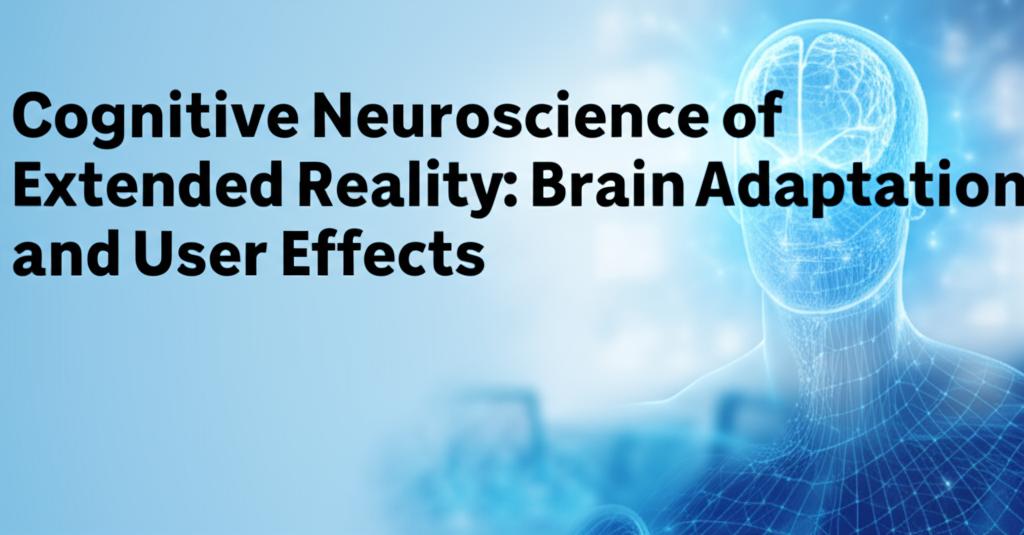Extended Reality (XR) technologies, which include virtual reality (VR), augmented reality (AR), and mixed reality (MR), are rapidly transforming our interaction with digital information and simulated environments. This article delves into the cognitive neuroscience of XR, exploring how the human brain adapts to these immersive experiences and the resulting effects on users.
Brain Adaptation and Neuroplasticity in XRThe brain exhibits a remarkable ability to adapt to XR environments, a phenomenon known as neuroplasticity. Research suggests that engaging in cognitively demanding tasks within XR can lead to the strengthening of neural connections. This is particularly relevant for aging populations and individuals recovering from brain injuries. XR can offer controlled and enriched environments for multisensory stimulation, which may help mitigate the negative cognitive and motor effects of prolonged inactivity, such as bed rest. Studies have shown that VR-based interventions can induce significant neuroplastic changes in brain regions like the hippocampus, prefrontal cortex, and motor cortex, leading to improvements in memory, spatial navigation, and executive functions.
Cognitive Load and Information ProcessingCognitive load theory is crucial in understanding how users process information in XR. XR environments can influence different types of cognitive load: intrinsic (related to task difficulty), extraneous (related to how information is presented), and germane (related to learning and schema construction). While XR can present rich information that benefits long-term memory and expands working memory capacity, it also has the potential to increase extraneous cognitive load if not designed carefully. Distractions and information complexity in XR can negatively impact information processing efficiency. Researchers are exploring how to optimize XR design to manage cognitive load effectively, for example, by dynamically adjusting task difficulty based on real-time physiological and neural data like EEG.
User Effects: Cognitive and Affective ImpactsXR's immersive nature significantly impacts user cognition and emotion.
- Enhanced Learning and Skill Acquisition: XR can create realistic and interactive learning experiences that improve knowledge retention and skill acquisition compared to traditional methods. The ability to actively participate in simulations and gain hands-on experience promotes deeper learning. Multisensory learning, microlearning, and repetition within XR environments are all factors that contribute to enhanced retention.
- Attention and Spatial Cognition: XR experiences can influence attentional processes. For instance, studies have shown that action-based XR games can improve attention and spatial cognition. Eye-tracking technology integrated with XR allows for the study of visual attention patterns and can even enable gaze-based interaction within virtual environments.
- Memory Enhancement: XR's ability to simulate real-world scenarios and allow for active interaction with virtual objects has been shown to enhance memory performance, particularly in older adults and those with mild cognitive impairment.
- Emotional Engagement and Empathy: The immersive quality of XR can lead to strong emotional connections with the content, potentially fostering empathy and providing a safe space for users to explore and manage their emotions.
- Motivation and Engagement: XR environments are often perceived as more engaging and motivating than traditional tasks, which can be particularly beneficial in educational and therapeutic settings, improving adherence to training programs.
The cognitive neuroscience principles of XR are being applied in various clinical contexts:
- Cognitive Assessment and Rehabilitation: XR offers ecologically valid tools for assessing cognitive functions like memory, attention, and executive functions. It allows for the simulation of daily activities, providing clinicians with realistic insights into a patient's cognitive performance. In rehabilitation, XR provides a safe and controlled space for patients recovering from traumatic brain injury (TBI), stroke, or those with neurodevelopmental disorders like Autism Spectrum Disorder (ASD) to practice cognitive and motor skills. VR-based rehabilitation programs have shown promise in improving motor function, spatial memory, and social cognition.
- Mental Health Treatment: XR is being used in therapies for psychological disorders, such as PTSD, anxiety disorders, and phobias. Immersive environments allow for exposure therapy in a controlled setting.
- Pain Management: VR has demonstrated potential in relieving pain, including phantom limb pain.
Despite the numerous benefits, several challenges need to be addressed:
- Cybersickness and Usability: Prolonged use of XR can lead to cybersickness (nausea, dizziness), eye strain, and physical discomfort, which can impact user engagement and data reliability. Usability and accessibility for diverse populations, including older adults and individuals with disabilities, remain key concerns.
- Cognitive Overload: Poorly designed XR experiences can lead to cognitive overload, hindering learning and performance.
- Long-Term Effects: More research is needed to understand the long-term psychological and neurological impacts of sustained XR use, particularly concerning how users distinguish between virtual and physical reality and the effects on cognitive development in children.
- Ethical Considerations: As XR becomes more pervasive, ethical concerns regarding data privacy, potential for psychological manipulation, and harassment within virtual environments need careful consideration.
Future research will likely focus on optimizing multimodal integration in XR, combining technologies like EEG, eye-tracking, and haptic feedback to create more adaptive and personalized experiences. Understanding the underlying neural mechanisms of brain adaptation to XR and exploring its therapeutic potential further will be crucial. The continued collaboration between neuroscience, cognitive science, and XR developers is essential to harness the full potential of these immersive technologies for human benefit while mitigating potential risks.

